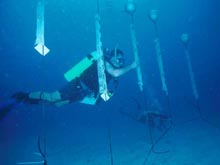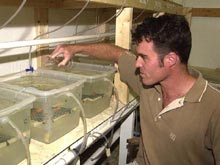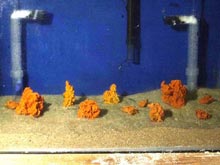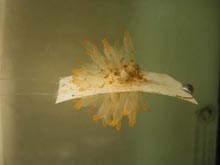
This is an experimental aquaculture farm of deep-water sponges that were transplanted at 60 ft depth. Pieces of sponges are placed inside mesh bags and anchored to the bottom. They are measured for growth and the production of bioactive chemicals. Click image for larger view.
Aquaculture and Cell Culture: Development Techniques for Marine-derived Drugs
September 15, 2003
Shirley Pomponi
Vice President and Director of Research
Harbor Branch Oceanographic Institution
Co-principal Investigator, Gulf of Mexico Expedition
Alan Duckworth
Postdoctoral Fellow
Division of Biomedical Marine Research
Harbor Branch Oceanographic Institution
Thousands of chemicals with pharmaceutical potential have been identified from marine organisms, and more have been found in sponges than any other group. With the enormous potential for discovery and development of these chemicals into drugs comes the obligation to develop methods by which these products can be supplied in a way that will not damage the ecosystem or deplete the resource.
The supply of most marine-derived chemicals is a major limiting factor for further pharmaceutical development. Often, the chemical occurs in very small amounts in the sponge or other "macroorganism" (like a gorgonian (sea fan) or an ascidian (sea squirt)), and even steady harvesting of these animals from the ocean cannot provide enough of the target chemical. In general, the natural abundance of the source animals will not support such a supply, anyway. Unless there is a feasible alternative to harvesting, promising chemicals will remain undeveloped.

The biomedical aquaculture laboratory at HBOI is used to conduct research on sponges and tunicates for drug development. Click image for larger view.
Some other options for supplies of these marine resources are chemical synthesis, cell culture, and aquaculture of the source organism. Each of these options has its advantages and limitations. Not all methods are applicable to every marine chemical, and some of the methods are still in development. The approach to be used is based on a number of factors, including:
(1) Complexity of the chemical: Can it be chemically produced? Chemical production (synthesis) of a molecule gives a pharmaceutical company ultimate control in the supply of materials for the development and eventual marketing of a drug. Synthetic processes have been established for many marine chemicals in development as pharmaceuticals. Unfortunately, most of these are multi-step processes that are often very expensive. To overcome this problem, the pharmaceutical industry conducts research to identify chemicals that are similar in molecular structure to the original chemical compound (the "parent molecule"), but which may be easier to produce, and perhaps even more potent and less toxic than the parent molecule.
(2) Source of the compound: Is it produced by a symbiotic microorganism or the animal itself? Some marine chemicals that were originally isolated from sponges were later discovered to occur in microorganisms that live in the sponge. If these microorganisms can be isolated and cultured, techniques could be improved to scale up the production for drug development (see essay, "Microbiology at Sea.")

Growth and feeding studies on sponges are conducted under controlled conditions in the HBOI lab. Click image for larger view.
If the source of the chemical is a sponge or another macroorganism, cell culture production methods may eventually be an option for supply. Because sponges are very simple animals with no tissues or organs, they can be dissociated into individual cells and placed in flasks. The cells are "cultured" in the flask with liquid nutrients and other components to stimulate them to grow and divide. Research in progress at Harbor Branch Oceanographic Institution (HBOI) focuses on establishing cell cultures of sponges that produce bioactive chemicals, so that we can understand the cellular and molecular processes that control production. In other words, why does the sponge produce the chemical, and what can we do to stimulate the cell cultures to grow, divide, and produce more of the chemical? This research may ultimately lead to the production of the drug via cultured sponge cells.
(3) Growth conditions in nature: Is aquaculture an option? Sponges and ascidians (sea squirts) can be farmed either in the sea (in situ culture) or in tanks on land (in vitro culture). Both culture methods require a thorough understanding of the ecology of the farmed animal. For in vitro culture, the environmental (e.g., temperature, light) and nutritional requirements of the farmed animal need to be supplied. Sponges and ascidians are sessile suspension feeders. Attached to the bottom, they feed by filtering bacteria and microalgae between 1 and 100 microns in size.
For in situ culture, sponges and ascidians can be farmed on suspended rope lines or in mesh bags. Food doesn't have to be provided when the animals are farmed in the sea. The sponges can filter food particles directly from the water currents flowing past the lines or bags. Mesh bags are ideal for soft, fleshy animals that may be torn off rope lines by strong water currents. The environmental conditions at the farming location will affect both the animal's growth and production of the target chemical. Farmed sponges and ascidians, whether in situ or in vitro, can grow rapidly. In favorable conditions, these animals can double their size in a month!

Tunicates that produce bioactive compounds are carefully studied in HBOI’s biomedical aquaculture lab. Click image for larger view.
Any animal targeted for aquaculture or cell culture can be collected using scuba, if it's a shallow-water species, or by submersible if it lives in deep water. Because sponges and some ascidians can regenerate themselves, they can be cut into many smaller pieces for aquaculture. Over time, the cut pieces heal and regrow. The farmed animals can also be harvested at regular intervals by cutting and removing any new biomass, leaving behind the original piece to regrow yet again. This will increase overall production of both biomass and the target chemical.
Both aquaculture and cell culture of marine organisms to supply drugs are recent concepts and require further study so that we can learn more about how to produce as much of the target chemical as possible. Once fully developed, these techniques could both reduce our need to harvest organisms from the ocean and supply sufficient amounts of the chemicals required to cure deadly diseases.
Sign up for the Ocean
Explorer E-mail Update List.





















